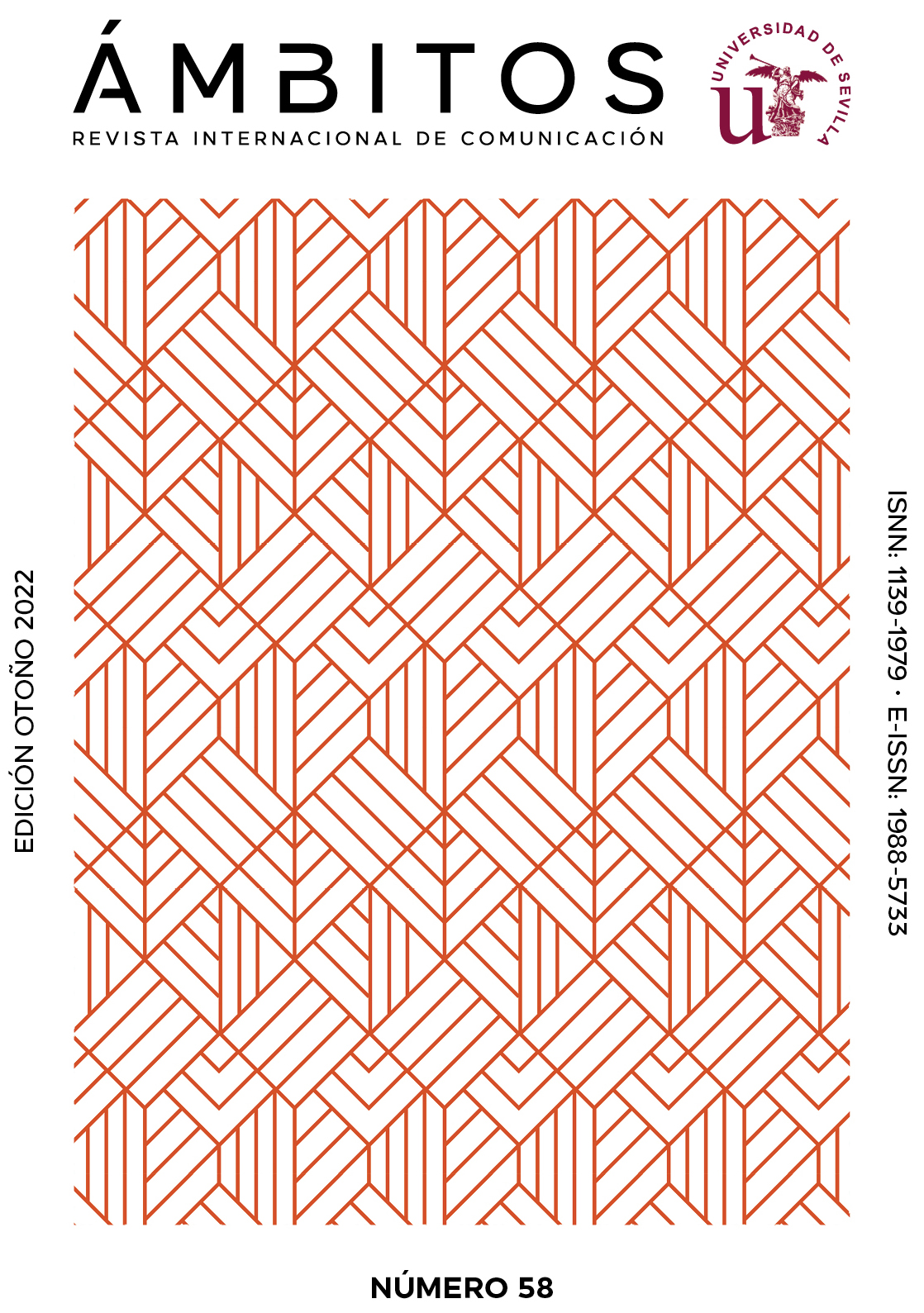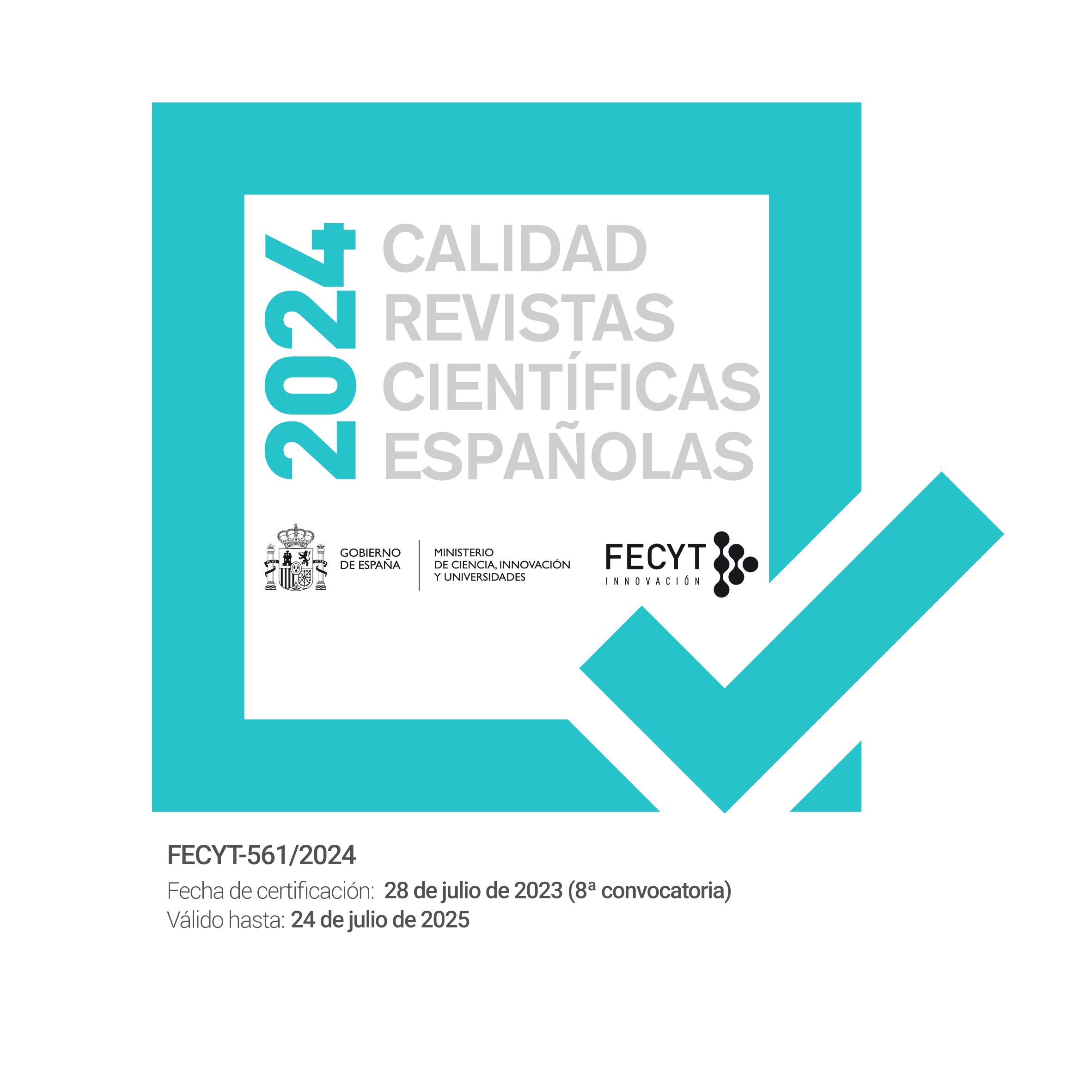Plataformas digitales y literatura. Anatomía del fenómeno ‘booktuber’ de habla hispana
DOI:
https://doi.org/10.12795/Ambitos.2022.i58.05Palabras clave:
BookTube, engagement, literatura, plataformas digitales, influencersResumen
Se presenta un estudio sobre las características de las producciones de los booktubers más relevantes en lengua hispana, centrado en los aspectos técnicos, los tipos de vídeos, así como los géneros y subgéneros literarios que abordan. Este análisis incluye un estudio del engagement de estas producciones (n=360) desde la estadística descriptiva e inferencial (estudio correlacional y de factores predictivos). En una segunda fase, se explora la percepción de los seguidores de este movimiento mediante la realización de un total de 34 entrevistas cualitativas estructuradas con el fin de conocer cuáles son los aspectos más valorados de este tipo de contenido y su influencia en el hábito lector. Estas producciones se centran en prescribir y analizar obras literarias, por ello los vídeos de tipo top, las recomendaciones y las reseñas son los contenidos más prominentes. Se observa un dominio absoluto de la novela frente a otros géneros como la poesía, el teatro o el ensayo. Los aspectos técnicos manifiestan una escasa capacidad predictiva del engagement de estas producciones. Los usuarios descubren este contenido de forma accidental y valoran la información sobre las obras por encima de la calidad y edición de los vídeos y del posicionamiento emocional del booktuber con respecto a los libros analizados. Asimismo, afirman haber reforzado su hábito lector desde que forman parte de la comunidad.
Descargas
Citas
Anderson, T. (2020). A Book Club for the 21st Century: An Ethnographic Exploration of BookTube. [Tesis doctoral, University of North Carolina at Chapel Hill]. UNC Digital Repository. https://cutt.ly/xJH8BDy
Aparici, R. y García-Marín, D. (2017). Comunicar y educar en el mundo que viene. Gedisa.
Aparici, R. y García-Marín, D. (2018). Prosumidores y emirecs: Análisis de dos teorías enfrentadas. Comunicar, 55, 71-79.
https://doi.org/10.3916/C55-2018-07
Ayres, D.J., De Mello-Pereira, M-H. y Oliveira-Azevedo, A.C. (2021). Booktube: um gênero discursivo advindo das Tecnologias Digitais da Informação e Comunicação. Entrepalavras, 11(3), 386-412.
http://dx.doi.org/10.22168/2237-6321-32210
Birke, D. (2021). Social Reading? On the Rise of a “Bookish” Reading Culture Online. Poetics Today, 42 (2), 149–172.
https://doi.org/10.1215/03335372-8883178
Bugess, J. y Green, J. (2009). YouTube: Online Video and Participatory Culture. Polity Books.
Callejo, J. y Viedma, A. (2005). Proyectos y estrategias de investigación social: la perspectiva de la intervención. McGraw-Hill.
Cantos-Vallecilla, I. (2017). Booktubers, los influenciadores de libros. [Tesis de Grado, Universidad del Rosario]. Repositorio Institucional EdocUR. https://cutt.ly/eJH9KhX
Cervi, L. y Marín-Lladó, C. (2021). What are political parties doing on TikTok? The Spanish case. Profesional de la información, 30(4), e300403.
https://doi.org/10.3145/epi.2021.jul.03
Chen, Q., Min, C., Zhang, W., Ma, X. y Evans, R. (2021). Factors Driving Citizen Engagement With Government TikTok Accounts During the COVID-19 Pandemic: Model Development and Analysis. Journal of Medical Internet Research, 23(2).
Corbetta, P. (2007). Metodologías y técnicas de investigación social. Mc Graw Hill/Interamericana de España.
Cuevas-Molano, E., Sánchez-Cid, M. y Gordo-Molina, V. (2022). Estrategia de marca y gestión de contenidos en Instagram: programación y longitud del mensaje como factores de mejora de engagement. Communication & Society, 35(2), 71-87.
https://doi.org/10.15581/003.35.2.71-87
De la Torre-Espinosa, M. (2020). El fenómeno Booktube, entre el fandom y la crítica literaria1. Álabe, (21).
https://doi.org/10.15645/Alabe2020.21.6
Díaz-Rosero, Y.D. (2019). Memes, podcast y formato booktuber, otras formas de lectura y escritura. Revista Ideales, (8), 83-05. http://revistas.ut.edu.co/index.php/Ideales/article/view/1879
Domínguez, B. (2016). Análisis del fenómeno booktube en España. [Trabajo de Fin de Grado, Universidad Politécnica de Valencia]. Repositorio Institucional UPV. https://cutt.ly/8JH34CW
Dubovi, I. y Tabak, I. (2021). Interactions between emotional and cognitive engagement with science on YouTube. Public Understanding of Science, 30(6), 759-776.
https://doi.org/10.1177/0963662521990848
Gao, W., Tian, Y., Huang, T. y Yang, Q. (2010). Vlogging. ACM Computing Surveys, 42(4), 1- 57.
http://doi.org/10.1145/1749603.1749606
Garcés-Estrada, W.E. (2018). BookTube como estrategia en la promoción y venta de libros en México. [Tesis de Licenciatura, Universidad Autónoma de México]. Repositorio Institucional UNAM. https://cutt.ly/GJH4ijV
García-Marín, D. (2020a). Escuchas de la Complejidad. Perfil y Taxonomía de los Usuarios en el Podcasting Independiente. En R. Longhi, A. Lovato y A. Gifreu (Coords.), Narrativas Complexas (pp. 207-228). Ria Editorial.
García-Marín, D. (2020b). Hacia una lingüística de la interacción mediática. Aproximación al diseño de la participación significativa medio-usuario desde el podcasting independiente. Profesional de la información, 29(5), e290505.
https://doi.org/10.3145/epi.2020.sep.05
García-Marín, D. y Salvat-Martinrey, G. (2022). Viralizar la verdad. Factores predictivos del engagement en el contenido verificado en TikTok. Profesional de la información, 31(2), e310210.
https://doi.org/10.3145/epi.2022.mar.10
Jenkins, H. (2010). Piratas de textos. Fans, cultura participativa y televisión. Paidós Ibérica.
Kujur, F. y Singh, S. (2018). Emotions as predictor for consumer engagement in YouTube advertisement. Journal of Advances in Management Research, 15(2), 184-197.
https://doi.org/10.1108/JAMR-05-2017-0065
Li, Y., Guan, M., Hammond, P. y Berrey, L. (2021). Communicating COVID-19 information on TikTok: a content analysis of TikTok videos from official accounts featured in the COVID-19 information hub. Health Education Research, 36(3), 261-271.
https://doi.org/10.1093/her/cyab010
Lluch, G. (2014). Jóvenes y adolescentes hablan de lectura en la red. Ocnos. Revista De Estudios Sobre Lectura, (11), 7-20.
https://doi.org/10.18239/ocnos_2014.11.01
López-Navarrete, A.J., Cabrera-Méndez, M., Díez-Somavilla, R. y Calduch-Losa, Á. (2021). Fórmula para medir el engagement del espectador en YouTube: investigación exploratoria sobre los principales youtubers españoles. Revista Mediterránea de Comunicación, 12(2), 143-156.
https://doi.org/10.14198/MEDCOM000013
Montes-Vozmediano, M., García-Jiménez, A. y Menor-Sendra, J. (2018). Los vídeos de los adolescentes en YouTube: Características y vulnerabilidades digitale]. Comunicar, 54, 61-69.
https://doi.org/10.3916/C54-2018-06
Rovira-Collado, J. (2017). Booktrailer y Booktuber como herramientas LIJ 2.0 para el desarrollo del hábito lector. Investigaciones Sobre Lectura, (7), 55-72.
https://doi.org/10.24310/revistaisl.vi7.10981
Segarra-Saavedra, J. e Hidalgo-Marí, T. (2018). Viralidad e inte-racción. Análisis del engagement de los diez anuncios más vistos en YouTube en España en 2016, Icono 14, 16(1), 47-71.
https://doi.org/10.7195/ri14.v16i1.1069
Sesek, L. y Pusnik, M. (2014). Reading popular literature and digital media: Reading experience, fandoms, and social networks. Anthropological Notebooks, 20(2), 103-126.
Sorensen, K. y Mara, A. (2014). Booktubers as a Networked Knowledge Community. En L. Marohang y B. Gurung, Emerging pedagogies in the networked knowledge society: practices integrating social media and globalization (pp.87-99). IGI Global.
Suárez, M.M. y González-Argüello, M.V. (2020). Becoming a Good BookTuber. RELC Journal, 51(1), 158-167.
https://doi.org/10.1177/0033688220906905
Sued, G. (2016). Formas distantes de ver Youtube: una exploración por la comunidad booktube. Virtualis, 7(14), 90-112.
https://doi.org/10.2123/virtualis.v7i14.189
Szmuda, T., Syed, M.T., Singh, A., Ali, S., Özdemir, C., y Słoniewski, P. (2020). YouTube as a source of patient information for coronavirus disease (Covid-19): a content-quality and audience engagement analysis. Reviews in Medical Virology, 30(5), e2132.
https://doi.org/10.1002/rmv.2132
Thomas, C., Jayagopi, D.B. y Gatica-Perez, D. (2019). BookTubing across regions: examining differences based on nonverbal and verbal cues. Proceedings of the 2019 ACM International Conference on Interactive Experiences for TV and Online Video, 145-156.
https://doi.org/10.1145/3317697.3323357
Toffler, A. (1980). La tercera ola. Plaza & Janés.
Torrego-González, A., Vazquez-Calvo, B. y García-Marín, D. (2021). El fandom de Blue Jeans: lectura y socialización literaria en línea. Ocnos. Revista De Estudios Sobre Lectura, 20(1), 65-81.
https://doi.org/10.18239/ocnos_2021.20.1.2459
Vizcaíno-Verdú, A., Contreras-Pulido, P. y Guzmán-Franco, M.D. (2019). Lectura y aprendizaje informal en YouTube: El booktuber. Comunicar: Revista científica iberoamericana de comunicación y educación, (59), 95-104.
https://doi.org/10.3916/C59-2019-09
Zhu, C., Xu, X., Zhang, W., Chen, J. y Evans, R. (2019). How Health Communication via Tik Tok Makes a Difference: A Content Analysis of Tik Tok Accounts Run by Chinese Provincial Health Committees. International Journal of Environmental Research and Public Health, 17(1).
Descargas
Publicado
Cómo citar
Número
Sección
Licencia
Derechos de autor 2022 David García-Marín, Cristina Herrero-Torrente

Esta obra está bajo una licencia internacional Creative Commons Atribución-NoComercial-CompartirIgual 4.0.
Ámbitos. Revista Internacional de Comunicación es una revista de acceso abierto, lo que significa que todo su contenido está disponible gratuitamente para el usuario o su institución. Los usuarios pueden leer, descargar, copiar, distribuir, imprimir, buscar o enlazar con el texto completo de los artículos, o utilizarlos para cualquier otro fin lícito, sin solicitar permiso previo al editor o al autor. Esta definición de acceso abierto se ajusta a la Iniciativa de Acceso Abierto de Budapest (BOAI).

A menos que se indique lo contrario, todo el contenido de la edición electrónica se distribuye bajo una " licencia internacional Creative Commons Attribution-NonCommercial-ShareAlike 4.0 ". Puede consultar la versión informativa y el texto legal de la licencia aquí. Esto debe indicarse expresamente de esta manera cuando sea necesario.
En caso de aceptación del manuscrito, los autores ceden los derechos de la obra para su publicación a Ámbitos. Revista Internacional de Comunicación bajo el contrato de licencia Reconocimiento-NoComercial-CompartirIgual 4.0 Internacional (CC BY-NC-SA 4.0). Los autores conservan los derechos de autor y terceros están autorizados a copiar, distribuir y hacer uso de la obra, siempre que cumplan con los términos y condiciones establecidos en la licencia.
- Citar la autoría y la fuente original de publicación (revista, editorial y URL de la obra).
- No los utilice con fines comerciales.
- Si remezcla, transforma o crea a partir del material, debe publicar sus contribuciones bajo la misma licencia que el original.
Se puede encontrar más información en https://creativecommons.org/licenses/by-nc-sa/4.0/deed.es



















